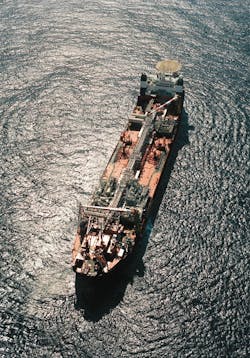Turnkey fast-track development for small field
Nick Terdre
Contributing Editor
Despite the climatic challenges of the South China Sea, the Navion Munin has achieved 98% operations uptime in the early months of producing the Lufeng 22-1 Field.The Navion Munin production ship that offshore shipping company Navion has provided for the development of Statoil's Lufeng 22-1 Field in the South China Sea has established itself as an important reference for the company's floating production capabilities.
The vessel, the first production ship based on Navion's multipurpose shuttle tanker (MST) concept, has lived up to expectations since first oil was produced in late December 1997.
This autumn, the company will see its second production ship, Berge Hugin, come into operation on Enterprise's Pierce Field in the UK sector.
A second success story will provide a further boost to Navion's credentials. "We want to build on this base and get a share of this market as a production contractor," says Allan Millmaker, senior vice president for floating production systems. "We see ourselves very much as a major player where FPSOs are concerned."
Navion's floating production niche covers smaller fields - up to around 100 million bbl - remote from infrastructure. Leasing and re-usability are integral parts of the concept, Millmaker says. The company is not in the market for the design and construction of field-specific vessels to be owned by the field licensees.
Turnkey fast-track
To provide a total production package, Navion works with partners which take responsibility for elements such as the processing facilities and subsea facilities. In the case of Lufeng, the company - at the time still Statoil's Shipping and Marine Technology division - combined with Advanced Production Systems, a Statoil/Aker Maritime owned company providing process facilities, and Stolt Comex Seaway (subsea facilities) to set up the Lufeng Development Company (LDC). The partners brought the field on stream only 15 months after the turnkey development contract was awarded.Provision of the submerged turret mooring system was subcontracted to APL, and of the production swivel to Framo Engineering, both companies partly owned by Navion. All the companies are Norwegian, making the Lufeng project an interesting example of Norwegian offshore contracting capability.
Lufeng 22-1 is a very marginal field, with estimated recoverable reserves of no more than 30 million bbl. The small size had defeated attempts by the first two operators to find viable ways of developing it. With a budget of less than $250 million, the Navion leasing approach makes a radical difference to the economics of development from the field owner's point of view.
It enables them both to pay as they use, thus avoiding hefty up-front outlays before cash-flow is generated, and to limit their exposure - in the case of Lufeng, the Navion Munin lease is for a firm period of only two years, with options for a further five years. And when the lease expires, field abandonment is much simplified for the licensees.
And from Navion's point of view, when the lease expires, the company is confident that the vessel's versatility will facilitate the task of finding it new work. As a floater it can easily be moved to a new location for further production work if this is available. If not, with a minimum of conversion it can undertake other functions, working as a storage unit, a shuttle tanker, or even in long-haul crude transport.
Production vessel
The Navion Munin is a 103,000-dwt vessel with a double hull, overall length of 253 meters and storage capacity of 640,000 bbl. Offloading to shuttle tanker is via a floating hose over the stern. The vessel has its own diesel-electric propulsion and dynamic positioning capability. The processing facilities can produce up to 60,000 b/d of crude and handle up to 125,000 b/d of fluids. Because of a high degree of automation in both vessel and process functions, the crew numbers no more than 40.The vessel is moored using the submerged turret system originally developed for shuttle tanker loading. For Lufeng, this has been designed for disconnection in 6-8 hours - the time designated by the Chinese authorities in the face of impending typhoons. When disconnected, the submerged turret buoy drops away to a depth of some 30 meters from which it can be easily retrieved for reconnection once the typhoon has passed.
The rotating connector/swivel stack which forms the interface between the topside and subsea facilities carries two 7-inch production paths, a high-voltage power path and hydraulic utility line and control signals. On disconnection, the swivel stack assembly is raised in its trolley and moved out of the way into a storage position.
Subsea support
The requirement for a high-power swivel was a special challenge. The power - 2000 kW - is required to run five mudline booster pumps developed, like the swivel, by Framo. Also like the swivel, this is their first commercial application - they provide artificial lift to the five subsea wells to compensate for an early decline in reservoir pressure and the increase in the water cut.The pumps were installed using the ship's motion-compensated aft crane and conventional guidewires, and can be retrieved for maintenance in the same way - two of the pumps have already been moved to different wells. The crane can also be used for light intervention tasks on the subsea trees.
As experience with the Navion Munin accumulates, Millmaker is pleased with the performance of both the vessel and the STP mooring and swivel. "The overall regularity of the Navion Munin production system has been exceptional, averaging over 98% in the first nine months of production," he says.
"On the negative side, oil price developments and reservoir performance have both been below expectations, resulting in a shorter field life and contract period. The experience gained from operating in China has placed us in a good position for further contracts in the South China Sea, as well as in the Asian region."
Copyright 1998 Oil & Gas Journal. All Rights Reserved.






